Related Research Articles

Fielding Harris Yost was an American college football player, coach and athletics administrator. He served as the head football coach at: Ohio Wesleyan University, the University of Nebraska, the University of Kansas, Stanford University, San Jose State University, and the University of Michigan, compiling a coaching career record of 198–35–12. During his 25 seasons as the head football coach at Ann Arbor, Yost's Michigan Wolverines won six national championships, captured ten Big Ten Conference titles, and amassed a record of 165–29–10.
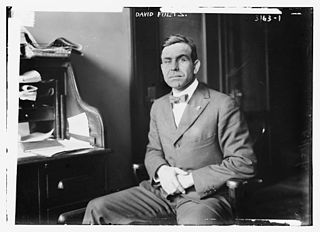
David Lewis Fultz was an American football and baseball player and coach. He played Major League Baseball as a center fielder in the National League with the Philadelphia Phillies (1898–1899) and Baltimore Orioles (1899), and for the Philadelphia Athletics (1901–1902) and New York Highlanders (1903–1905) of the American League. He batted and threw right-handed. In a seven-season career, Fultz posted a .271 batting average with 223 RBI and three home runs in 644 games played. Fultz played college football and college baseball at Brown University, from which he graduated in 1898. He served as the head football coach at the University of Missouri (1898–1899), Lafayette College (1902), Brown (1903), and New York University (1904), compiling a career college football coaching record of 26–19–2. Fultz was also the head baseball coach at the United States Naval Academy in 1907 and at Columbia University from 1910 to 1911.

George Edkin Little was an American football player, and coach of football, basketball, and baseball, and college athletics administrator.

Frederick Mitchell Walker, nicknamed "Mysterious", was an American athlete and coach. He was a three-sport athlete for the University of Chicago from 1904 to 1906 and played Major League Baseball as a right-handed pitcher for the Cincinnati Reds, Cleveland Indians, Brooklyn Superbas, Pittsburgh Rebels and Brooklyn Tip-Tops.

Frederick James Murphy was an American football, basketball, and baseball player and coach and college athletics administrator. Murphy served as the head football coach at Northwestern University (1914–1918), University of Denver (1920–1922), and University of Kentucky (1924–1926), compiling a career football coaching record of 40–37–4. He was also the head basketball coach at Manhattan College (1912–1913) and at Northwestern (1914–1917), and the head baseball coach at Northwestern (1914–1916) and Kentucky (1925–1926). In addition, Murphy served as Northwestern's athletic director from 1913 to 1918.
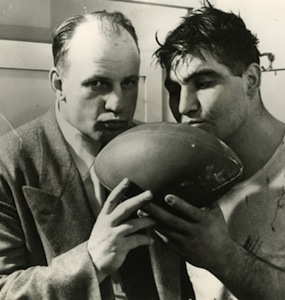
Werner Robert Voigts was an American football and basketball player and coach. He served as the head football coach at Northwestern University from 1947 to 1954, compiling a record of 33–39–1. Voigts led the 1948 Northwestern Wildcats team to the Rose Bowl, the first in school history, where they defeated California, 20–14.

Michael Joseph "Iron Mike" Donahue was an American football player, coach of football, basketball, baseball, tennis, track, soccer, and golf, and a college athletics administrator. He served as the head football coach at Auburn University, at Louisiana State University (1923–1927), and at Spring Hill College (1934).
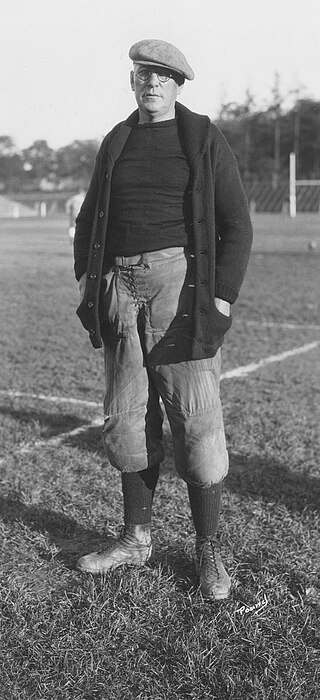
George Foster "Sandy" Sanford was an American college football player and coach. He served as the head coach at Cornell University (1896), Columbia University (1899–1901), the University of Virginia (1904), and Rutgers University (1913–1923), compiling a career coaching record of 89–49–7. Sanford was inducted into the College Football Hall of Fame as a coach in 1971.

Arthur Howe was an American football player and coach, teacher, minister and university president. He played college football for Yale University from 1909 to 1911, was the quarterback of Yale's 1909 national championship team, and was a consensus first-team All-American in 1912. He was the head coach of the 1912 Yale football team. Howe was later ordained as a Presbyterian minister and taught at Eastern preparatory schools and at Dartmouth College. From 1930 to 1940, he was the president of Hampton University. He was posthumously inducted into the College Football Hall of Fame in 1973.
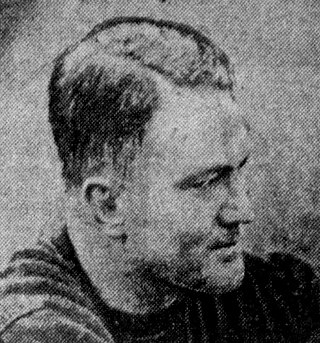
Marvin Allen "Mal" Stevens was an American football player, coach, naval officer, and orthopedic surgeon. He served as the head football coach at Yale University from 1928 to 1932 and New York University (NYU) from 1934 to 1941. He was elected to the College Football Hall of Fame as a player in 1974.
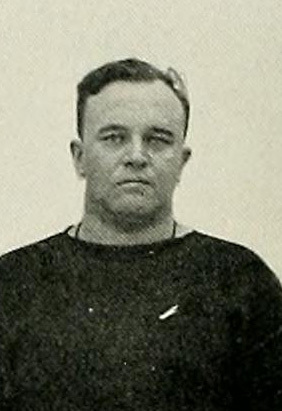
Myron Elmer Fuller was an American football player and coach.
Richard E. Eustis was an American college football player and coach. He played football at Wesleyan University from 1911 to 1913 and served as the university's head football coach from 1914 to 1915. He also served as the head football coach at New York University (NYU) in 1916.

John Farrell "Big John" Macklin was an American football player, coach of football, basketball, baseball and track and field, and a college athletics administrator. He served as the head football coach at Michigan Agricultural College, now Michigan State University from 1911 to 1915. With a five-year record of 29–5, he has the highest winning percentage of any football coach in Michigan State history. Macklin coached the Michigan State Spartans football team to its first ever victories over Ohio State, Michigan, Wisconsin, and Penn State. He was also the athletic director at Michigan Agricultural and coached the school's basketball, baseball, and track and field teams. Macklin tallied marks of 48–38 as head basketball coach (1910–1916) and 52–27 as head baseball coach (1911–1915).
Fred H. Clapp was an American football and basketball coach.

Harry Walter "Buck" Ewing was an American football player, coach of football, basketball and baseball, and college athletics administrator. He was a 1909 graduate of University of Nebraska where he played football. Ewing served as the head football coach at Morningside College (1911), South Dakota State College (1912–1917), Ohio Wesleyan University (1919–1921), Miami University (1922–1923), and Otterbein College, compiling a career college football record of 82–82–10. He was also the head basketball coach at South Dakota State, Ohio Wesleyan (1919–1920), Miami (1922–1924), and Otterbein (1942–1952), tallying a career college basketball mark of 117–111–1.

Thomas Joseph Thorp was an American college football player and coach, sports writer, and football and horse racing official. He served as the head football at Fordham University from 1912 to 1913 and New York University (NYU) from 1922 to 1924, compiling a career coaching record of 21–17–4.
Dan C. Kenan was an American football player and coach. He played football for Wesleyan University in 1913 and 1914 and served as the head coach of the Wesleyan football team in 1916 and 1920. His .750 winning percentage as Wesleyan's head football coach ranks third in the 127-year history of Wesleyan football.
Danny Hutchinson was an American college football player and coach. He played football for the University of Pennsylvania in 1908 and 1909 and served as the head football coach at Wesleyan University in 1913.
Henry Homer Hobbs was an American football player and coach. He played college football at Yale University and was selected as a consensus All-American at the tackle position in 1909. He also served as the head coach at Amherst College from 1910 to 1913, compiling a 13–17–2 record with the Lord Jeffs.
The 1913 NYU Violets football team was an American football team that represented New York University as an independent during the 1913 college football season. In their only year under head coach Jake High, the team compiled a 0–8 record.
References
- ↑ "Brown Yearly Results". College Football Data Warehouse. Archived from the original on February 11, 2010. Retrieved June 12, 2010.
- ↑ "BROWN HUMBLES YALE: WINS GAME AT NEW HAVEN; Rolls Up Total of 21 Points While Yale Is Unable to Score in First Defeat at Rivals' Hands". The Indianapolis Star. November 6, 1910.
- ↑ William Hanford Edwards (1916). Football Days: Memories of the Game and of the Men Behind the Ball. Moffat, Yard and Co. p. 417.
- 1 2 "BROWN FOOTBALL ANNOUNCES ITS ALL-DECADE TEAMS". Brown University Athletics (official site). August 17, 2003. Archived from the original on July 8, 2011. Retrieved June 14, 2010.
- ↑ "127 SEASONS OF WESLEYAN FOOTBALL". Wesleyan University. Archived from the original on June 1, 2010. Retrieved June 12, 2010.
- ↑ "WESLEYAN VICTORY OVER BROWN ELEVEN: Spectacular Dash Down Field by Eustis--Jake High Pleased Veteran Halfback on Yale Eleven". The Hartford Courant. October 14, 1912. Archived from the original on November 2, 2012.
- 1 2 "Coach High's Old Team Coming" (PDF). The New York Times. November 15, 1913.
- ↑ "Yale Yearly Results". College Football Data Warehouse. Archived from the original on February 13, 2010. Retrieved June 12, 2010.
- ↑ "COACH HIGH MAKES GOOD AT WESLEYAN". The Hartford Courant. November 6, 1912. Archived from the original on November 2, 2012.
- ↑ "ALL-TIME COACHING RECORDS". Wesleyan University. Archived from the original on June 1, 2010. Retrieved June 11, 2010.
- ↑ "HIGH MAY NOT COACH WESLEYAN". The Christian Science Monitor. March 21, 1913. Archived from the original on November 2, 2012.
- 1 2 "Chum - Bob's Sporting Talk". The Evening Independent. January 21, 1914.
- ↑ The Ultimate Guide to College Football, James Quirk, 2004
- ↑ "Jake High Records by Year". College Football Data Warehouse. Archived from the original on February 13, 2010. Retrieved June 12, 2010.
- 1 2 "1913 NYU Game-by-Game results". College Football Data Warehouse. Archived from the original on May 25, 2011. Retrieved June 12, 2010.
- ↑ "New York University 1913 football record". Archived from the original on May 25, 2011. Retrieved March 7, 2008.
- ↑ "Tom Reilly N.Y.U. Coach: Alumnus of University To Take Place of Jake High in Football" (PDF). The New York Times. January 16, 1914.
- ↑ "Brown Has Long Drill". The Day, New London, Conn. October 20, 1914.
- ↑ The Scroll of Phi Delta Theta. Phi Delta Theta. 1914.